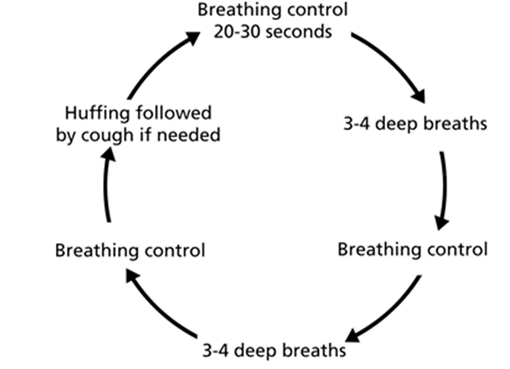- Reference Number: HEY1415-2023
- Departments: Therapies
- Last Updated: 1 August 2023
Introduction
This leaflet has been produced to provide instructions on how to effectively clear your chest. Most of your questions should be answered by this leaflet. It is not intended to replace the discussion between you and your physiotherapist, but may act as a starting point for discussion.
If after reading it you have any concerns or require further explanation, please discuss this with a member of the healthcare team caring for you.
What is ACBT
People with lung problems often produce more phlegm (sputum) than is usual. It is important to remove sputum from your lungs to help you breathe easier, reduce coughing and prevent chest infections.
ACBT is a set of exercises which aims to loosen secretions and move the sputum up your airways to enable you to cough up and clear your chest. The ACBT exercises are breathing control, deep breathing and huffing. ACBT can be completed in sitting or lying, the most effective position will be discussed with you by your physiotherapist.
Breathing Control
Rest your hand lightly on your stomach. Breathe gently, in and out quietly through your nose if possible. As you breathe in your stomach should rise and as you breathe out it will fall. You should do breathing control for 20 to 30 seconds or as long as you feel you need to.
Deep Breathing
Deep breaths help to get the air behind any sputum in your airways. Take a long, slow, deep breath in through your nose if you can and breathe out gently through your mouth. Try to breathe right down to the bottom of your lungs, expanding your ribcage. Aim to do three to four deep breaths before returning to breathing control.
Huffing
A huff is exhaling through and open mouth and throat, it is different to coughing. It helps moves sputum up your airways. Open your mouth and use your tummy muscles to help quickly squeeze the air from lungs as if you were trying to steam a mirror or your glasses. Do not force the air so much it makes you wheezy or cause tightness in your chest.
The ACBT Cycle

You will be informed by how long you should carry the ACBT for and what position you should complete the ACBT in.
Important tips
Only cough if you can hear phlegm when you huff. If not, return to the beginning of the cycle.
If you feel yourself going a bit dizzy then stop and go back to breathing control.
Increase the number of times that you repeat this cycle if your chest becomes more productive (phlegm-filled) than normal.
Should you require further advice on the issues contained in this leaflet, please do not hesitate to contact the Bronchiectasis/Cystic Fibrosis Department on Telephone Number 01482 622495.
General Advice and Consent
Most of your questions should have been answered by this leaflet, but remember that this is only a starting point for discussion with the healthcare team.
Consent to treatment
Before any doctor, nurse or therapist examines or treats you, they must seek your consent or permission. In order to make a decision, you need to have information from health professionals about the treatment or investigation which is being offered to you. You should always ask them more questions if you do not understand or if you want more information.
The information you receive should be about your condition, the alternatives available to you, and whether it carries risks as well as the benefits. What is important is that your consent is genuine or valid. That means:
- you must be able to give your consent
- you must be given enough information to enable you to make a decision
- you must be acting under your own free will and not under the strong influence of another person
Information about you
We collect and use your information to provide you with care and treatment. As part of your care, information about you will be shared between members of a healthcare team, some of whom you may not meet. Your information may also be used to help train staff, to check the quality of our care, to manage and plan the health service, and to help with research. Wherever possible we use anonymous data.
We may pass on relevant information to other health organisations that provide you with care. All information is treated as strictly confidential and is not given to anyone who does not need it. If you have any concerns please ask your doctor, or the person caring for you.
Under the General Data Protection Regulation and the Data Protection Act 2018 we are responsible for maintaining the confidentiality of any information we hold about you. For further information visit the following page: Confidential Information about You.
If you or your carer needs information about your health and wellbeing and about your care and treatment in a different format, such as large print, braille or audio, due to disability, impairment or sensory loss, please advise a member of staff and this can be arranged.
